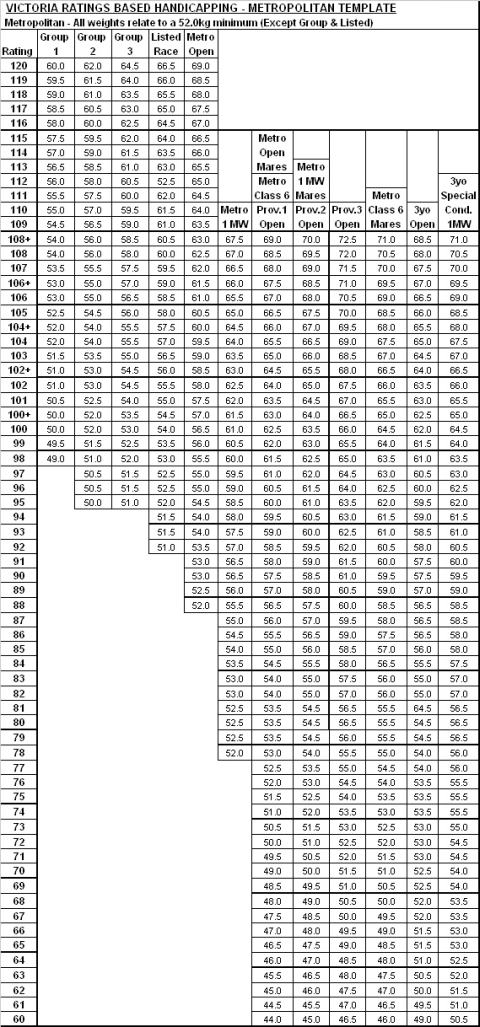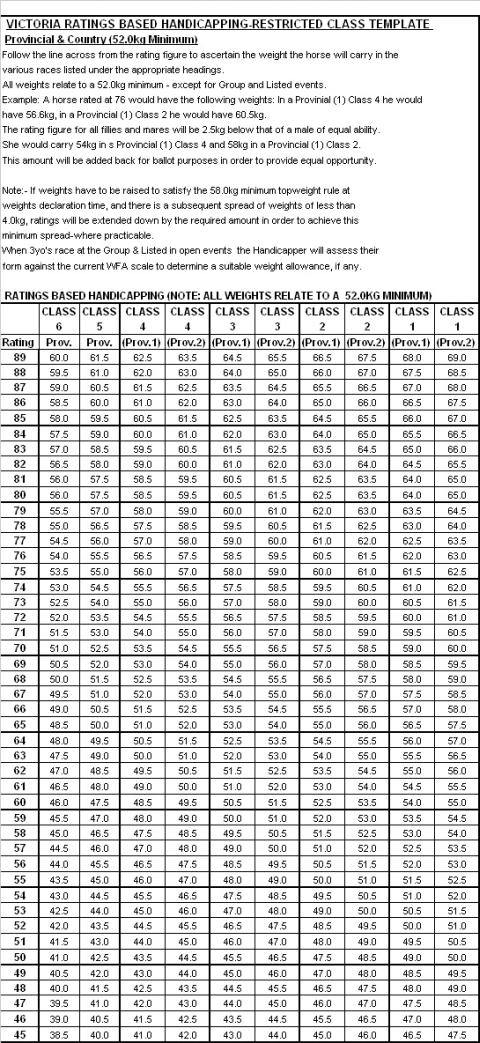In Part 1 of this series, I explained the new ratings-based handicapping system as it will operate in New South Wales. This article will give an oversight into how the ratings-based handicapping system will operate in Victoria.
Unfortunately, the Racing Victoria Handicapping Panel is not yet up to speed in regard to the amount of publicly available information in a similar manner to that already provided by Racing New South Wales.
Having contacted Racing Victoria, I was informed by their Chief Handicapper, Jim Bowler, that once the Melbourne spring carnival was out of the way, they would be moving into the second phase of their ratings-based handicapping system, which would include the launching of a website sometime in December, 2003.
At the time this article is being written, the website has yet to materialise.
In Victoria, the handicappers handicap from the top weight downwards to the required minimum. In other words, it is the ability of the topweight which determines the amount or spread of the weight scale. Therefore, a number of horses rated on the minimum will naturally be racing out of their class and thus seemingly disadvantaged by the scale of weights.
However, these horses are eligible to enter other more suitable events whilst, in the majority of circumstances, horses weighted above the minimum will either be eligible only for that grade or have displayed competitive form at this particular level.
A winning performance attracts a penalty. That is, a horse which wins a race will generally have its rating, within that particular class or level of competition, increased or extended in terms of those horses which it has beaten.
The severity of the re-handicap will depend on a number of factors, which include strength of opposition, authority and merit of win, margins and time, etc. The average winning re-handicap within the same level of Victorian racing is between approximately 2kg and 2.5kg. Wins by greater than average margins will naturally attract a larger re-handicap.
In most cases, placegetters will also attract a penalty, depending on the merit of the performance and their proximity to the horse immediately ahead of it in the finishing order.
Also, horses which run close-up in higher grades and then drop back to restricted-type events will, on most occasions, receive a penalty relevant to their performance at the higher level.
Generally, horses which finish past fourth or fifth and/or a significant distance from the placegetters, will have their rating lowered. However, defeat, no matter how far from the winner, must never be excessively rewarded. By way of example, that is why you will generally find that all horses finishing, say, sixth and beyond (maybe five-plus lengths from the winner) will all be lowered uniformly by 1kg, and not more, in the re-handicaps.
The role of the handicapper is to deliver competitive and interesting racing to the industry and to the public. The handicapper also has a responsibility to provide an environment in which owners and trainers can feel confident that their horses have a winning chance in terms of relative weight adjustments made in respect to exposed form.
Every owner and trainer, as well as the general public, has a right to understand the way in which horses are handicapped.
While handicapping is about personal and professional judgements, there are no right or wrong answers. Hindsight is a wonderful tool and handicappers must be able to provide a logical and reasoned explanation for each decision they make.
Unfortunately the rules and regulations which govern the structure of handicaps throughout Australian racing are not uniform. In Victoria, the minimum top-weight at the time handicaps are declared for all flat races shall not be less than 58kg.
By way of example, the same minimum top-weight applicable to New South Wales racing is 55.5kg. The rules which generally govern the minimum weights in Victoria are basically determined by prize-money.
However, with the introduction of the ratings-based handicapping system, the anomalies that exist between New South Wales and Victoria should be reduced and, hopefully, eliminated over time.
In Victoria, the single-figure ratings assessment for each horse will only be reviewed when that horse races under similar circumstances and/or over distances that are clearly within its established level of competition, with the rating reflecting a proven performance range.
Jim Bowler explained that this is very relevant to stayers commencing a campaign over shorter distances well short of their best.
One of the most important and significant changes will be that horses on the minimum weight will be displayed in ratings order. As an example of how the new system works, let’s consider three of the runners that contested race 7, a 1600m Class 4 race, at Bendigo on November 13.
Sensational Swing was the topweight on 56.5kg (4.5kg above the minimum), which translates to a rating of 76. He was on a four-day back-up after finishing third at Cranbourne over the same distance and class, beaten a half length, and carrying the same weight.
Given its previous performance, normally this horse would have been penalised half a kilogram but, as its proven distance range was over a shorter distance, it was not re-handicapped and remained on a rating of 76 and 56.5kg.
The second topweight was the Lee Freedman-trained Kalera King, who had previously raced in a 1500m Class 5 at Geelong to finish second, beaten a length, with 53kg on a 52kg Limit, which translates to a rating of 71.
Coupled with the drop in class, that performance led to a re-handicapping to an assessed rating of 75 and a weight of 56kg for the Bendigo race. Although the result was to prove me incorrect, my initial thoughts were that Kalera King had been a little harshly treated by about half a kilogram.
The third of the runners was the 5yo mare Henpecked, who was freshened-up from a break of 26 days after a poor performance at Bendigo in a 1600m Class 4 in mid-October, beaten 5.5 lengths, for seventh place.
At her previous run, she had carried 54kg on a 53kg Limit, with an assessed rating of 69. However, because of her poor performance, she had been re-handicapped to a rating of 67 and, therefore, was weighted on the minimum weight of 52kg.
The result of the race again proved that the handicapper’s treatment of Kalera King was correct, as he started an even-money favourite and won by 1.75 lengths. Sensational Swing finished second as the $5.50 third-favourite and Henpecked, who was clearly outclassed by the other two, finished fifth at $18.


By EJ Minnis
PRACTICAL PUNTING MONTHLY - JANUARY 2004